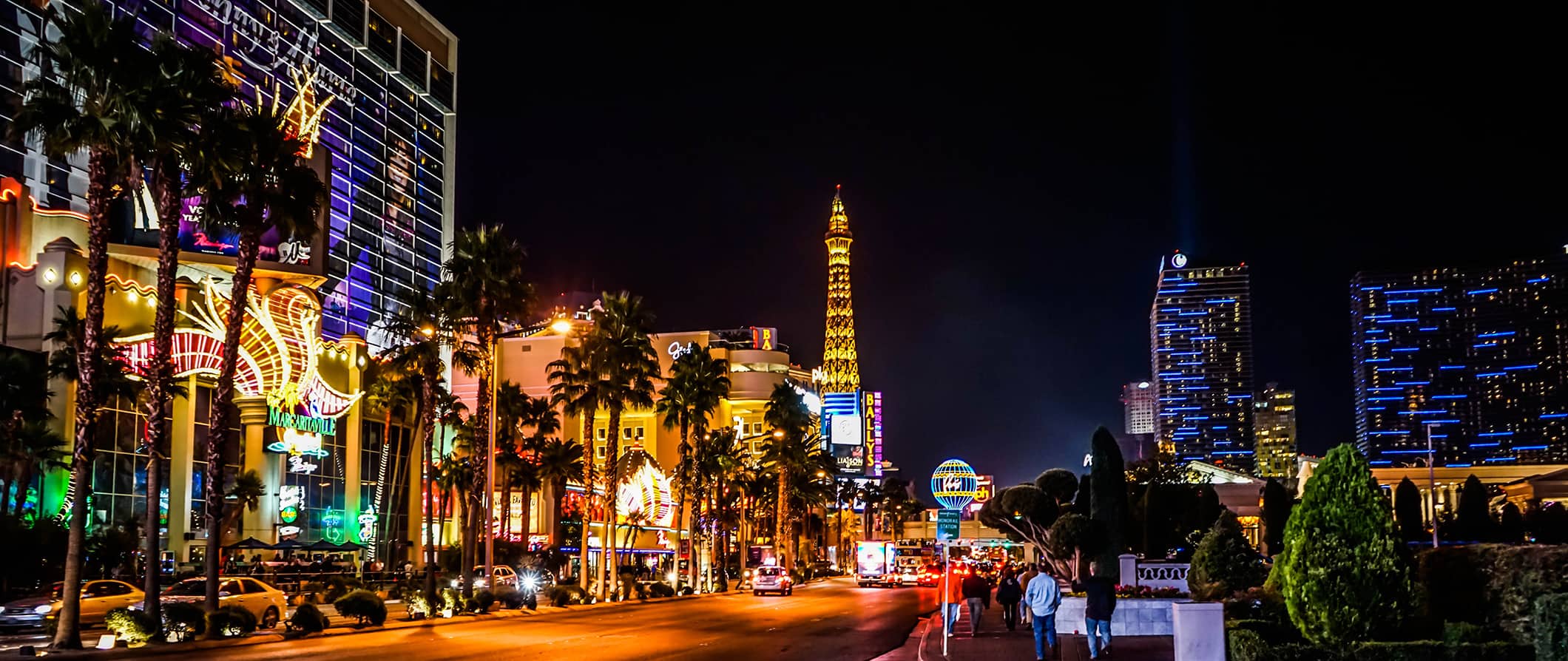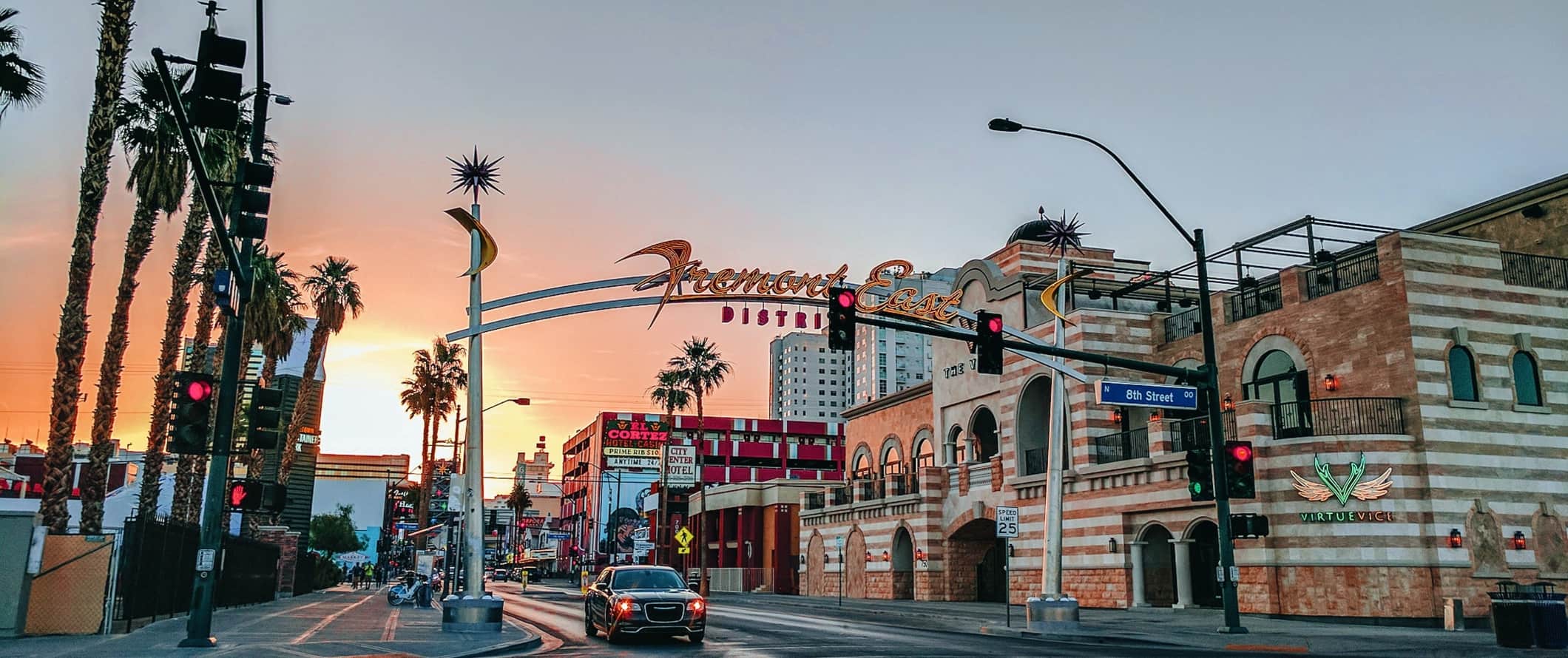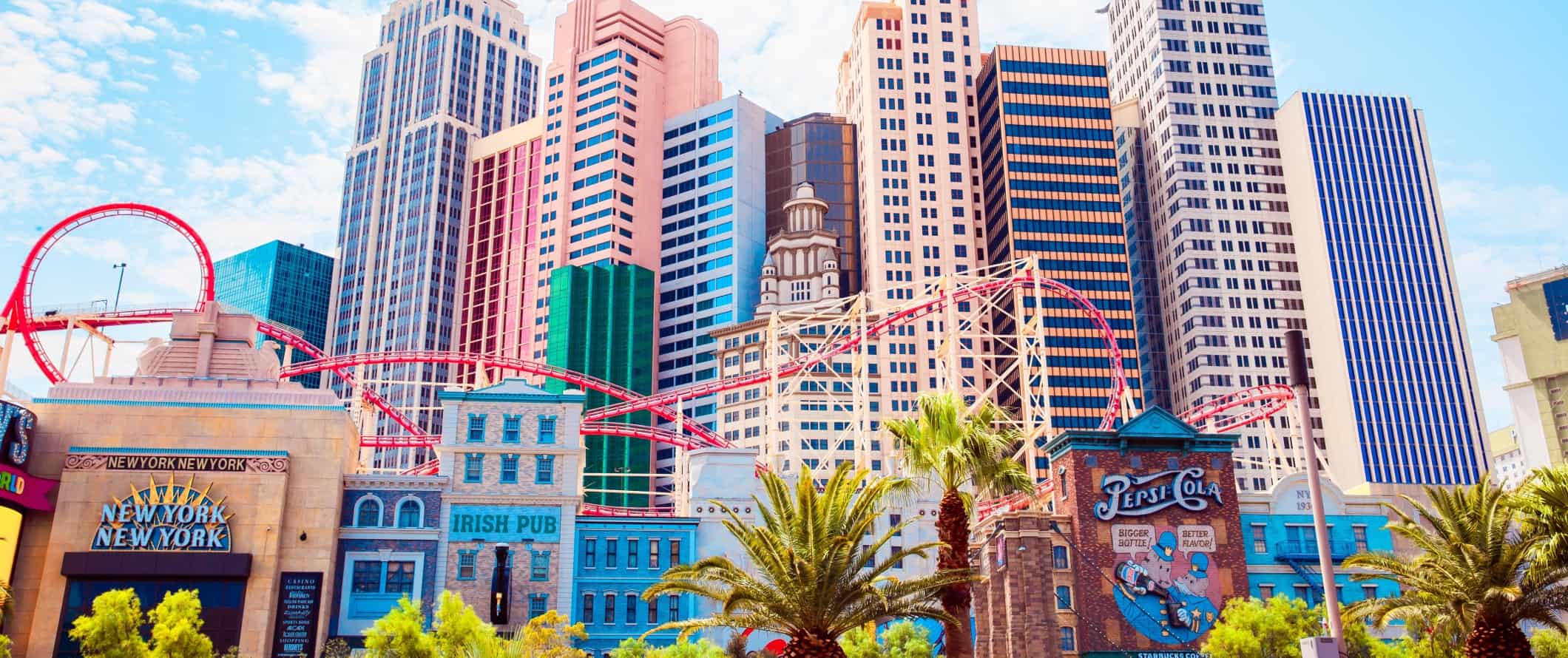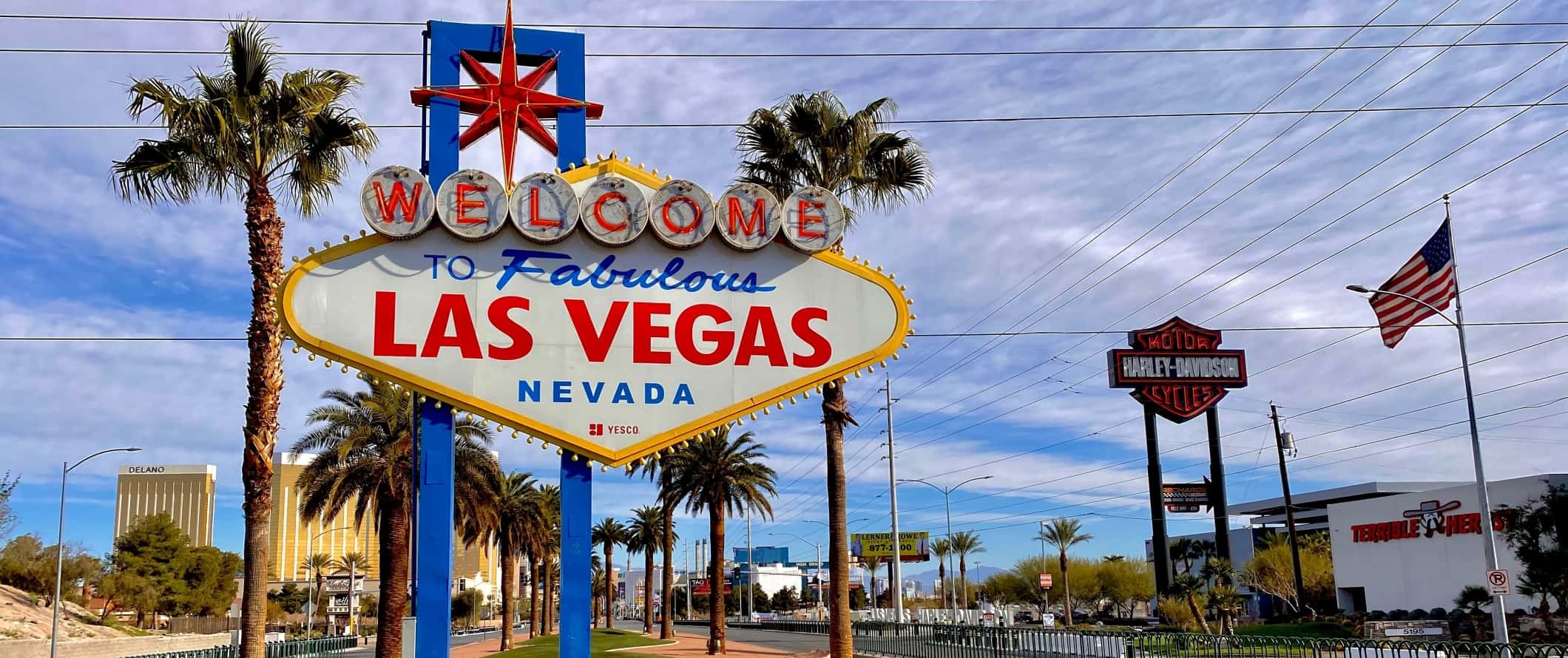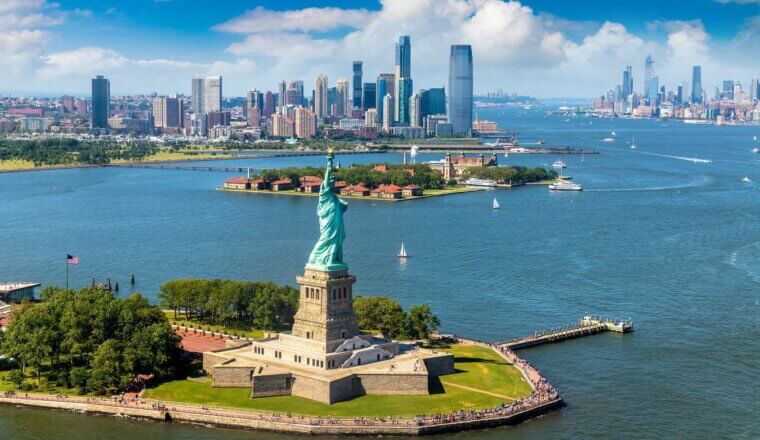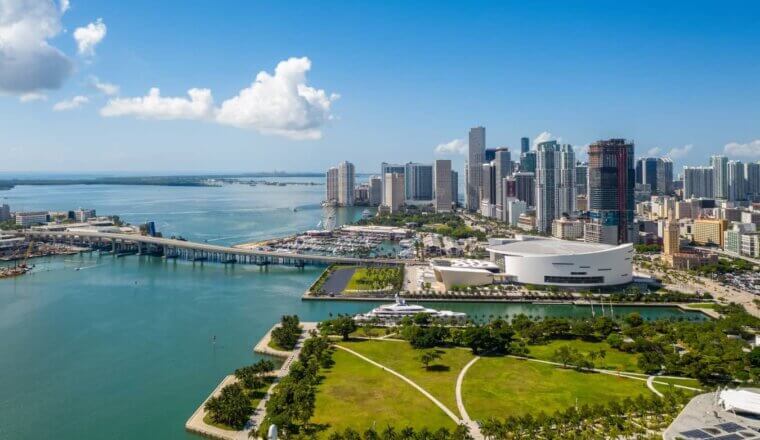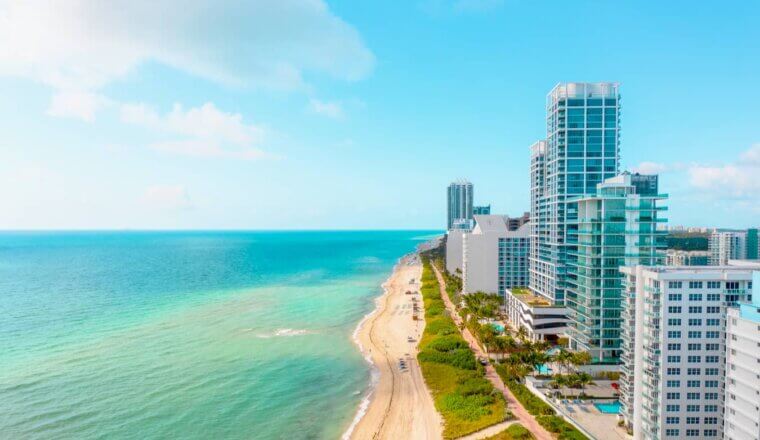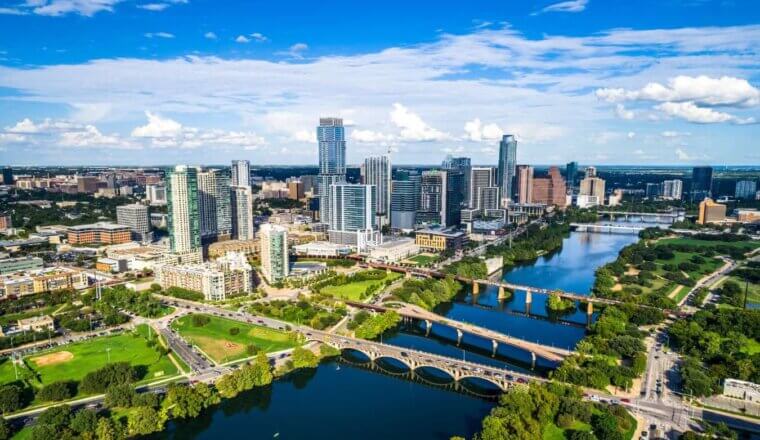Nestled in the Nevada desert, Las Vegas is a sprawling city of glitzy hotels, bustling casinos, wild nightclubs, and world-class restaurants. A lot of people don’t like Vegas – the party, the showiness, the expensive resorts, the fancy see and be seen atmosphere.
But there’s more to visiting Sin City than just the Strip. This city is home to a growing art scene, incredible shows, an amazing mix of restaurants, events, nearby hiking, and history. The downtown area is being revived, there’s so much good food here (did I mention that? lol), and friendly people.
This travel guide to Vegas can help you navigate the city on a budget and show you that there’s more to Vegas than the Strip.
Table of Contents
Top 5 Things to See and Do in Las Vegas
1. Take in a show
Vegas does entertainment better than anywhere else. You can find some of the best acts in the world here, from magic shows to comedy acts, circus performances to musicals. It’s often a good idea to book tickets with your accommodation as it can work out to be cheaper. Use Tix4Vegas (operated by Tix4Tonight) to find tickets for shows that night for up to 50% off. They have booths at Showcase Mall, Bally’s Grand Bazaar, and Casino Royale.
2. Experience Fremont Street
Fremont Street is where Vegas was born. The city’s first hotel opened up here in 1906, it became the city’s first paved street in 1925, and the first gaming license was issued to an establishment on Fremont in 1931. Today, Fremont Street offers a very different scene from the Strip, with dive bars, older casinos, and more of a New Orleans Bourbon Street vibe. It’s a great area for entertainment, people-watching, and cheap drinks. The Fremont Street Experience (FSE) on the western end of the street is a pedestrian mall with nightly light shows and street performances.
3. Splurge on a meal
Las Vegas has some of the best food in the world. With all that money flowing in, it is easy to see why. You can find every type of cuisine and every type of restaurant here, from Michelin-starred restaurants to gigantic, bottomless brunch buffets. A trip here isn’t complete without at least one fine dining experience. My favorite restaurants are Yellowtail (Bellagio), Lemongrass (Aria) The Peppermill, and Firefly.
4. Head to Hoover Dam & Lake Mead
Completed in 1936, the Hoover Dam is the country’s largest reservoir. Its massive curved wall towers 726 feet (221 meters) above bedrock and holds back over 9 trillion gallons of water in Lake Mead. It is an impressive feat of engineering, and the dam’s hydroelectric generators provide power to Nevada, Arizona, and California. This project was an important part of how the desert states of the Southwest were able to develop. The dam is free to see but the visitor center with its exhibits and observation deck costs $10 USD. A guided tour of the power plants and dam costs $30 USD. This will take you through the tunnels and you’ll get to ride the original elevator. You’ll visit the viewing platform and even get to see the massive Colorado River from inside the dam.
5. Visit the Neon Museum
This outdoor lot is brimming with the huge neon signs that once beckoned you into casinos like the Silver Slipper, Stardust, and El Cortez. The museum recently expanded and now features more signs, a park, and guided tours of their collection. For each sign, there are displays to read about its story and significance in Vegas history. Daytime admission is $20 USD and nighttime tours cost $25 USD. Make reservations in advance as this is a very popular attraction and it often sells out. The museum also offers “Neon Night Flights,” nighttime helicopter tours of Vegas’s neon lights (tickets start at $199 USD, which includes a guided tour and light show at the museum).
Other Things to See and Do in Las Vegas
1. Take a trip to the Grand Canyon
You can combine a trip to the Grand Canyon with an outing to Hoover Dam if you take one of the many coach tours (start around $110 USD). These take an entire day as the canyon isn’t that close to the city. Since they are over 250 miles (400 kilometers) away (a tour of the Canyon and Hoover Dam can easily take up to 14 hours). While I think the Grand Canyon deserves its own trip, if this is the closest you can get to it, a rushed visit is better than no visit. Tours with Get Your Guide take around 10 hours and cost $165 USD.
If possible, rent a car instead. That will give you more flexibility and will likely be cheaper if you can split a rental.
2. Explore Shark Reef Aquarium
As one of the most prestigious sea-life centers in the world, Shark Reef Aquarium is a must-see. Shark Reef tunnel, which is designed to look like a sunken ancient shipwreck, allows you to come face to face with over 2,000 species of sharks, sawfish, giant rays, endangered green sea turtles, and rare golden crocodiles. Holding over 1.3 million gallons, the aquarium’s main tank is one of the largest in North America. The aquarium is located in the Mandalay Bay Resort and tickets cost $29 USD for admission and a VR experience. There’s also an option to add the experience of feeding sharks or stingrays. Prices for the add-ons start at $65 USD.
3. See Vegas from The STRAT
Offering the best views of Vegas, The STRAT is the tallest free-standing observation tower in the US. If you’re feeling brave, consider trying the rides at the top. The aptly named X-Scream propels you headfirst 27 feet over the edge of the tower and leaves you hanging 850 feet in the air. Admission to the Sky Pod Observation Deck costs $20 USD. Adding a “Thrill Ride” is as little as $1 per ride, depending on the time of day, while Sky Jumps (think bungy jumping) start at $149 USD.
4. Hike Red Rock Canyon
If the bright lights of Vegas get too much for you, head out to Red Rock Canyon for a day of hiking. A road rings the canyon, and each trailhead has a parking lot where you can leave your car to go hike before driving to the next trailhead. At 2.5 miles (4 kilometers) long, the Calico Tanks trail is the most popular in the area. You pass a natural water tank on the way, which leads up to a summit offering a great view of Las Vegas. Make sure to come early in the morning before it gets too hot, and bring a lot of water, a hat, and sunscreen. The entrance costs $20 USD per vehicle (or $5 USD if you’re a pedestrian), and the scenic loop is open from 6am to at least 5pm. Other popular trails worth checking out are the Ice Box Trail (2.6 miles/4 kilometers), Keystone Thrust (2.2 miles/3.5 kilometers), and the White Rock-Willow Spring Loop (4.4 miles/7 kilometers).
If you’d rather splash out than hik, helicopter tours over Red Rock last 2-3 hours and cost $239 USD.
5. Check out the Mob Museum
Las Vegas started with the mafia. Bugsy Segel built the Flamingo and, since then, the mob has controlled Vegas (see the movie Casino, which is based on a true story). With the rise of mega-resorts, the mob has less influence these days, however, there would be no Vegas without the mafia. This detailed, eye-opening museum showcases the history of the mob and Vegas. It’s super informative! Don’t miss The Underground, a speakeasy and distillery underneath the museum where you can try Prohibition-era cocktails with moonshine crafted on-site. Fun fact: my family used to be involved with the mob out in Vegas. Admission is $34.95 USD (save $10 USD on admission by buying “happy hour” tickets online and visiting after 5pm Sunday-Friday or before 11am on Saturday).
6. See the Mirage Volcano
Set to its own soundtrack, this man-made volcano erupts finely choreographed fireballs and smoke 100ft into the air from the waters below, turning the waterfall to molten lava. It’s located at the Mirage (on the Strip) and has been erupting since the hotel opened in 1989. The volcano show happens nightly at 8pm, 9pm, 10pm, and 11pm. It’s one of the many free nightly displays on the Strip that hotels use to attract and captivate visitors.
7. Visit the Venetian
The Venetian Las Vegas is a luxury hotel, resort, and casino that, with a staggering 7,092 rooms, is the 2nd-largest hotel in the world. The architecture and construction of this casino are magnificent and one of the best on the Vegas Strip. While gondola rides are super cheesy, overpriced, and touristy (just like in Venice!), it’s worth spend some time walking through here. It’s super pretty and makes for a good stroll. Plus, it’s free!
8. Watch the Bellagio Fountain Show
The Bellagio resort offers a magnificent nightly light and water display set to music. The show has 4,792 lights and uses 1,214 water nozzles to send jets of water soaring as high as 460 feet (140 meters) across the 8.5-acre man-made lake in front of the hotel. I think it’s overhyped (probably due to Ocean’s 11), so while I wouldn’t make my night revolve around it as some people do, it’s worth seeing if you’re nearby. Check the Bellagio website for showtimes.
9. Hang out in Boulder City
Along the way to the Hoover Dam, this suburb offers a taste of local life in the area. Milo’s is the hot restaurant in this town. Check out the Public Art Scape, which consists of more than thirty unique sculptures spread throughout the town. You can also visit the free Hoover Dam Museum. It’s designed to give you a glimpse into the lives of the men and women who settled the town and built the dam during the Great Depression. Take a walk or bike along the Historic Railroad Trail that takes you through the tunnels and along the railroad bed that was used to move the materials needed to build the Hoover Dam. If you’re a golfer, there are a few courses around as well. There’s also a main street and some shopping you can do. Strolling around this quiet little community is a nice contrast to the crowds of Vegas.
10. Go golfing
There are many golf courses in Vegas, including Shadow Creek, considered one of the best and most expensive courses in the world (it costs $1000 – $1,250 USD to golf here). If you aren’t a member of any local clubs, many of the casinos can arrange day passes. You can find tee times starting at $30 USD per person on weekdays.
11. Get artistic at First Friday
On the first Friday of every month, the downtown area fills up with exhibits and displays from local artists during First Friday. It’s free and a great way to get a sense of the local art scene as well as mix with locals. The event hosts live music, food trucks, and vendors selling their various creations. It’s a great way to see what life looks like for the people who live and work in Las Vegas. Be sure also to check out Arts District 18B, the arts center of Las Vegas, which is home to cool bars, shops, galleries, and more.
12. Visit the Pinball Hall of Fame
If you’ve got nostalgia for the vintage-style pinball machines of your childhood arcade days, visiting the Pinball Hall of Fame (near the Strip) is a must. After moving to a new location in 2021, this museum now spans 25,000 square feet and is dedicated entirely to classic pinball games. Admission is free, though playing the games does cost money. Make sure you bring lots of quarters!
13. Come for the Life is Beautiful Festival
Life is Beautiful is a huge music and arts festival that takes place every September in downtown Las Vegas. You get all the big-name musicians, but there’s also lots of unique entertainment – Bill Nye and Rosario Dawson are just two of the festival’s past guests. Plus, the whole downtown core gets transformed into an open-air art gallery as street artists make the city their canvas. Even if you’re visiting after the festival is over, you still get to appreciate these artworks.
14. Check out the Arts Factory
Located in the Arts District downtown, the Arts Factory is a stark contrast to the glitz and glam of the Strip. Inside this 50-year-old warehouse, you’ll find galleries, studios, and all kinds of live art events (poetry readings, plays, etc.). While First Friday is the most active time to visit, you can really visit anytime. The exhibitions are always changing so there’s always something new going on. Check their website for an up-to-date schedule. It’s free to visit too.
15. Have fun at Area15
This immersive entertainment complex is hard to describe. It’s kind of like an indoor theme park and performance venue and retail center all rolled into one. There are events and performances (live music, drag shows), as well as dance party events with DJs. There are bars inside (including a bar and arcade combined) as well as several games and activities (like ax throwing). In short, it’s a huge complex with all kinds of weird and wonderful things to do. It’s free to enter, and then you pay for whatever activities you want to do. If you plan to go on a Friday or Saturday night after 10pm, book your activities in advance, as otherwise, you’ll have to pay $10 USD to get into the complex.
Las Vegas Travel Costs
Hostel prices – There are currently only a couple of hostels in Vegas. During peak season, a bed in a 4-6-bed dorm room starts at $45 USD. For a room with 8 beds or more, expect to pay around $40 USD. During the off-season, a bed in a room with 8 beds or more costs around $30 USD a night, and a bed in a 4-6-bed dorm is about $40 USD. Free Wi-Fi is standard and both hostels here have kitchens for cooking your own meals. Neither offers private rooms.
Budget hotel prices – You can find tons of cheap budget hotel options in Vegas near the Strip or downtown. Budget two-star hotels start around $90 USD in peak season and $65 USD off-peak when you factor in resort fees which usually add around $30 per night to the listed price.
There are lots of Airbnb options in Vegas, but not many are located near the Strip. Plus, there are so many high-end hotels offering low prices, you don’t really need to consider Airbnb. A private room starts around $60 USD per night while entire homes/apartments start at $100 USD. Expect to pay double (or triple) if you don’t book early.
Food – You can find everything in Vegas, from comfort food to international eats, fast food to luxury plates. It’s all here. In Chinatown, not far from the Strip, you’ll find traditional dim sum and plenty of reasonably priced places to get a good meal. One of the great things about Las Vegas is you can find food at all hours, especially in the main tourist areas.
If you’re on a budget, you can find cheap eats in Vegas at hotels and casinos where there are buffets costing $25-35 USD. While not exactly cheap, you can really fill up on food here and likely skip a meal later.
Towards the middle of the Strip near Horseshoe, there are a number of cheap chain restaurants like Chipotle, McDonald’s, and Subway where you can find cheap fast food. Slices of pizza go for about $6 USD and you can find burgers for $10 USD. Chinese takeout is $12-15 USD for a combination plate, which includes an entree, egg roll, and rice.
Vegas has lots of mid-range dining options, especially around downtown and Fremont Street. You can dine out for $15-20 USD per main course, including meat and pasta dishes.
A beer costs about $5-8 USD (but if you want to really save money, grab a beer from a corner store for less than $5 USD — you can drink on the street here). A glass of wine is $11-14 USD (at least). Cocktails are $13-16 USD in a restaurant or cocktail bar, but there are plenty of places to find cheap drinks around the Strip and Fremont, especially during happy hours.
A latte/cappuccino costs around $5.50 USD while bottled water is around $2 USD.
Vegas has some of the best high-end dining restaurants in the world, and you really should splurge on at least one good meal. You can get a prix-fixe three-course meal starting around $100 USD and can spend more than $500 for a meal in this city! But you can also get really delicious meals with two courses for about $55 USD.
If you cook your own food, expect to pay $50-65 USD per week for groceries including pasta, rice, vegetables, and some meat.
Two of my favorite restaurants here are Lotus of Siam and Esther’s Kitchen.
Backpacking Las Vegas Suggested Budgets
If you’re backpacking Vegas, expect to spend $80 USD per day. This budget covers a hostel dorm, using public transportation to get around, cooking your own meals, limiting your drinking, and doing free activities like the fountain shows and wandering Fremont. If you plan on drinking, add at least $10-20 USD to your budget per day.
A mid-range budget of $195 USD per day covers staying in a budget hotel or private Airbnb, eating out most of your meals at cheap restaurants, enjoying the occasional buffet, having a few drinks, gambling a bit, and doing some paid attractions such as seeing Hoover Dam or going to a concert.
On a “luxury” budget of $405 USD or more per day, you can stay in a hotel on the Strip, eat out at mid-range restaurants, drink more, see more shows, and rent a car to go on a trip to the Grand Canyon. This is just the ground floor for luxury though. The sky is the limit!
Las Vegas Travel Guide: Money-Saving Tips
You can visit Las Vegas on a budget if you’re mindful of your spending. However, you can easily burn through money really, really quickly here if you aren’t careful (two drinks at the bar could cost you $40 USD!). Here are some ways to stay on a budget in Vegas:
- Skip the weekend – Most people visit Las Vegas on a Friday or Saturday and stay for the weekend, which means this is the most expensive time to visit. By visiting the city during the week, you can enjoy significantly reduced room rates and restaurant prices.
- Gamble responsibly – It’s Vegas, so of course, you want to risk a few dollars in a casino. Just don’t go wild. Only gamble what you can comfortably afford to lose because the house always wins.
- Get comps – If you’re gambling, casinos often reimburse some of your losses in the form of meals, discounted show tickets, and rooms. Make sure to ask about these!
- Redeem hotel points – Be sure to sign up for hotel credit cards and use those points when you travel. There’s nothing better than free accommodation and most cards come with at least 1-2 nights free. This post can help you get started with the basics so you can start earning points today and have plenty for your trip.
- Use coupons – Coupons are almost a currency in Las Vegas; casinos give you a book of them when you sign up for a (free) players card, and you can find 2-for-1 offers on meals in restaurants on the Strip.
- Don’t pay cabs with a credit card – Many taxis charge a $3 USD service charge when you pay with a credit card. Avoid the charge by paying cash.
- Eat at the buffet – To fill up on food, stick to the all-you-can-eat buffets. They cost about $25-35 USD per meal and you can really pack it on!
- Eat cheap at 5-star restaurants – Prime-time seating at the Strip’s five-star restaurants is between 8-10pm, but these hot spots like to be full all the time, so most have both happy hour and pre-show menus to kick off their evenings between 4pm-7pm.
- Go to Late Night Happy Hour – Most Vegas restaurants stop serving food by 10:30pm, but there are so many performers finishing up about that time that the Strip has a tradition of the post-10pm (or 11pm, depending on the place) “late night happy hour,” with food and drinks starting around $5 USD.
- Do brunch – A boozy brunch is a Sin City staple. The best ones come with unlimited food and drinks on the weekends. (I order my mimosas bottomless and tell them to “hold the juice.”)
- Drink at the casino before hitting the club – To cut down on expensive drinks at the clubs, drink on the casino floor. The drinks are free as long as you’re playing one of the games. Sit down at a penny slot machine, play slow, and drink fast. You can have 10 drinks for the price of one at the club! Just make sure you tip the waitress.
- Get discount tickets to shows – My favorite part about staying near the Strip is getting to see so many shows. Tix4Vegas has booths at Showcase Mall, Bally’s Grand Bazaar, and Casino Royale. There you can find tickets for shows that night for up to 50% off. You can also get them online too.
- Get the Go City Las Vegas Pass – This pass allows you to see a large number of attractions (and includes a free hop-off, hop-on tour as well as transportation on The Deuce). A two-day pass is $154 USD, a three-day pass is $264 USD, and a five-day pass is $344 USD with nearly fifty attractions to choose from. Some of the things you can enjoy with this pass are a free tour of the Hoover Dam, free entrance to Marvel Avengers S.T.A.T.I.O.N., and free entry to the Eiffel Tower experience.
- Save money on rideshares – Uber and Lyft are cheaper than taxis and are the best way to get around a city if you don’t want to take a bus or pay for a taxi — especially if you’re going to/from the airport.
- Hang out on Fremont Street – Drinks on the Strip are pricey. Save money by drinking down on Fremont. Drinks are much cheaper there!
- Bring a reusable water bottle – Vegas gets super hot (you’re in the desert after all!) so bring a reusable water bottle to keep you hydrated. The tap water is safe, but you can use a filter like LifeStraw to ensure your water is always clean.
For more money-saving tips in Las Vegas, check out my comprehensive post on how to save money in Vegas without breaking the bank!
Where to Stay in Las Vegas
Vegas only has a couple hostels since most people who come here want to live like a rock star for a few days. You can often find mid-week deals at local hotels and casinos for the same price or less than the hostel and be closer to all the action. Just be aware that most casinos also have a resort fee. If you want to stay in a hostel, here are my recommended places to stay:
How to Get Around Las Vegas
Public Transportation – Most of the Strip is connected via tunnels and walkways, but when it’s too hot, the monorail is a good option for getting around. The monorail stops at seven different points on the Vegas Strip, including several different major hotels. A one-way ride is $5.50 USD, while a one-day pass is $13.45 USD. You can buy up to a seven-day pass, depending on how long you’re staying.
The bus system in Vegas is known as The Deuce. It’s one of the best ways to get between downtown and the Strip, with the two main routes are The Deuce on the Strip and the SDX. A single-ride is $4 and a two-hour bus pass is $6 USD, while a 24-hour pass is $8 USD. A three-day pass is $20 USD. You can buy tickets on the bus, from ticket vending machines, or on the rideRTC, Lyft, and Uber apps.
The city also provides a free shuttle service that stops at many of the main districts and attractions. The Las Vegas Downtown Loop runs Monday-Thursday, 11am-6pm, and Fridays and Saturdays from 3pm-10pm.
Taxis – Taxis start at $3.50 USD to start and go up by $2.76 USD per mile. Many taxis also charge a processing fee of around $3 USD if you don’t pay cash. Also, if you take a taxi from the airport there is a $2 USD surcharge. Fixed rates from the airport start at $17-27 USD per zone and go up from there. Since traffic here can be a pain it’s best to just skip the taxis if you can.
Ridesharing – Uber and Lyft are cheaper than taxis and are the best way to get around the city if you don’t want to take a bus or pay for a taxi. They do add up though so skip them if you can.
Car rental – Car rentals can be found for as little as $38 USD per day for a multi-day rental. You’ll need to be at least 21 years old to rent a car. For the best rental car prices, use Discover Cars.
When to Go to Las Vegas
Vegas is busy all year-round, but especially during the winter months when the rest of North America comes seeking Nevada’s hot, desert temperatures.
Spring and fall temperatures are pleasant, with highs averaging between 69-82°F (20-28°C). There are a lot of festivals and outdoor events during these seasons. The Electric Daisy Festival, a huge electronic music festival, happens in May. Both the iHeart Radio and Life is Beautiful music festivals happen in September.
Summer is a scorcher, with temperatures reaching 105°F (40°C). It’s a good time to visit though because prices are lower. All the casino resorts and indoor spaces are well-equipped with air conditioning to keep you cool. Many of the resorts have pools and shaded areas outdoors as well.
It’s especially busy in Las Vegas during the week between Christmas and New Years’ and also at the end of January when a lot ofthe conventions are in town. March in Vegas can be total chaos when Spring Break and college basketball hits so, if you want lower prices and fewer crowds, definitely do not come during these times!
How to Stay Safe in Las Vegas
Las Vegas is a safe place to visit, including if you’re a solo traveler or solo female traveler. Violent attacks are rare, but like all big cities, practice caution wherever you go. Vegas does have some gang violence, but if you stick to Fremont Street and the Strip you likely won’t come in contact with it.
As a general rule, don’t walk alone at night in unlit places and keep your valuables secure at all times. Keep an eye on your wallet while in large crowds on Fremont Street or on public transportation.
Be wary of buying things from street vendors. This is especially true for event tickets as the tickets are often fake.
Solo female travelers should generally feel safe here, however, the standard precautions apply (never leave your drink unattended at the bar, never walk home alone intoxicated, etc.).
Worried about getting ripped off? Read about common travel scams to avoid here (though there aren’t too many scams here).
If you’re hiking, always bring water and sunscreen, especially during the summer. If you rent a car, don’t leave any valuables in it overnight. While break-ins are rare, it’s always better to be safe than sorry.
If you experience an emergency, dial 911 for assistance.
Always trust your gut instinct. Make copies of your personal documents, including your passport and ID. Forward your itinerary along to loved ones so they know where you are.
The most important piece of advice I can offer is to purchase good travel insurance. Travel insurance protects you against illness, injury, theft, and cancellations. It’s comprehensive protection in case anything goes wrong. I never go on a trip without it as I’ve had to use it many times in the past. You can use the widget below to find the policy right for you:
Las Vegas Travel Guide: The Best Booking Resources
These are my favorite companies to use when I travel. They consistently have the best deals, offer world-class customer service and great value, and overall, are better than their competitors. They are the companies I use the most and are always the starting point in my search for travel deals.
- Skyscanner – Skyscanner is my favorite flight search engine. They search small websites and budget airlines that larger search sites tend to miss. They are hands down the number one place to start.
- Hostelworld – This is the best hostel accommodation site out there with the largest inventory, best search interface, and widest availability.
- Booking.com – The best all around booking site that constantly provides the cheapest and lowest rates. They have the widest selection of budget accommodation. In all my tests, they’ve always had the cheapest rates out of all the booking websites.
- Get Your Guide – Get Your Guide is a huge online marketplace for tours and excursions. They have tons of tour options available in cities all around the world, including everything from cooking classes, walking tours, street art lessons, and more!
- SafetyWing – Safety Wing offers convenient and affordable plans tailored to digital nomads and long-term travelers. They have cheap monthly plans, great customer service, and an easy-to-use claims process that makes it perfect for those on the road.
- LifeStraw – My go-to company for reusable water bottles with built-in filters so you can ensure your drinking water is always clean and safe.
- Unbound Merino – They make lightweight, durable, easy-to-clean travel clothing.
- Top Travel Credit Cards – Points are the best way to cut down travel expenses. Here’s my favorite point earning credit cards so you can get free travel!
Las Vegas Travel Guide: Related Articles
Want more info? Check out all the articles I’ve written on United States travel and continue planning your trip:
